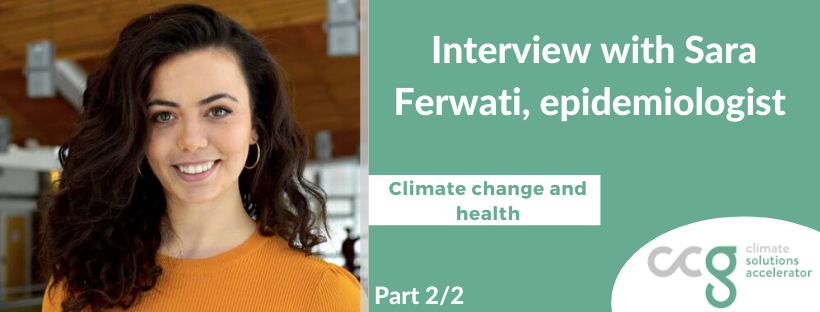A study published in May 2020 showed that unbearable temperature and humidity conditions for humans have been measured in recent years, even though models only predicted these conditions for the end of the 21st century. These extreme conditions are one of the health consequences of climate change. The development and update of several pandemic resilience plans is an opportunity to integrate climate resiliency into our urgency response plans.
To learn more about this topic, we spoke with Sara Ferwati who is an epidemiologist working in Nunavut. She has obtained an MSc in Public Health and an MSc in biochemistry from McGill University. She is also the Co-founder of Climatable, a Montreal-based non-profit organization focused on involving Canadians in climate action.
In the first blog, we explored the links between climate change and population health in the context of Canada, the impact of climate change on the Canadian healthcare system, and ways in which Canadian governments can respond. We continue the conversation below.
1 – How can one analyze the costs of climate change on healthcare systems?
SF: “Climate risk in the context of healthcare is a case of risk accumulation. This means that it increases the severity of existing threats and gives rise to new risks that, while they may not directly correlate with each other, can reinforce one another. These connections can be understood by drawing connections between health risks outlined in the first blog. As such, there is no straightforward way to analyze the costs, because the full impact of climate change on health is often difficult to measure. To have a complete cost estimate, it is necessary to take an integrated approach. This approach should not only consider the conventional medical costs, but the cost associated with the decreased quality of life that is associated with the burden of climate-related events. Similarly, social support programs are considered public health interventions, and so an inclusive cost analysis should include the cost of these interventions. The main lesson learned from this pandemic is that failure to build a resiliency plan will be costly, and an effective adaptation plan that addresses the existing health risks is paramount to reduce cost.“
2. Given the current COVID context, we expect many local and regional governments to invest in pandemic resiliency plans. What are the trade-offs and synergies between pandemic resiliency and climate resiliency?
SF: “First, for the synergies:
During the pandemic, every market sector has somewhat shifted towards teleworking, including the healthcare sector. If this shift endures post-lockdown, this can help with:
- Reducing transportation-related greenhouse gas emissions while also decreasing health risks associated with pollution.
- Reducing socioeconomic and health gaps that currently exist in rural and remote communities, gaps which climate change will worsen.
Some of the current pandemic investments have gone towards strengthening countries’ disease surveillance, information technology, and surge capacity. Many of these investments could be used to monitor all sorts of climate-related diseases and to enhance the physical capacity of emergency rooms and mental health services in response to both pandemics and climate-related disasters.
The Canadian government put in place multiple social assistance funds to address the consequences of the pandemic. The secondary health threats and consequences from the precautionary measures of the pandemic mirror those of climate change. The administrative infrastructure built to deliver resources to communities in need can also be scaled to address climate-related events.
Second, for the trade-offs:
The emergency funds that can be used to respond to climate-related disasters can also be used to respond to pandemics such as COVID-19. For example, Alberta government has fished $153 million out of its emergency and disaster fund to respond to the COVID-19 pandemic and help hard-hit farmers. This means that the ability of Alberta to respond to future climate-related disasters is diminished due to the necessary cost associated with COVID-19.
Communities most vulnerable to the pandemic are also most vulnerable to climate change. This makes proper disaster aid response more challenging and costly, as it would require equipment and strategies that reduce risk of infection spread.”
3- Taken together, what do you think local government officials should focus on to improve both pandemic resiliency and climate resiliency?
SF: “Here are some steps I believe governments need to take to address both pandemic and climate resiliency, in order of complexity.
First, the high demand for medical supplies, especially masks and hand sanitizers, led to shortages, posing a great risk on health care staff. Local production would address the limiting factors associated with imports and distribution. This would not only reduce emissions related to imports, but also allow for greater response speed to outbreaks and climate change related disasters.
Second, there needs to be an increase in investment in culturally competent mental health programing. These programs are needed to address the depression, anxiety, grief, and post-traumatic stress that result from experiencing pandemics and climate-related disasters.
Third, governments can promote urban design measures being undertaken to address crowding in public spaces, such as increasing size and reach of pedestrian and bicycle paths. These measures reduce both the risk of infection in the public transport systems during a pandemic while promoting the development of low-carbon transportation modes.
Fourth, but certainly not the least, the COVID-19 pandemic has highlighted some of the socioeconomic inequalities that exist in our communities. These include but are not limited to issues of crowded housing and inaccessibility of social benefit programs to refugees. These inequalities increase the risk of infections while further exacerbating the disadvantages faced by such groups. Therefore, identifying and addressing these inequalities is an important leverage for increasing our resiliency to both pandemics and climate change.”
Interviewed by Amir Nosrat
The entire CCG team would like to thank Sara Ferwati for answering our questions. We invite you to discover Climatable, the non-profit organization co-founded by Sara.

